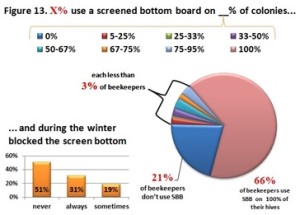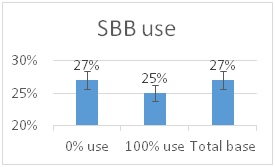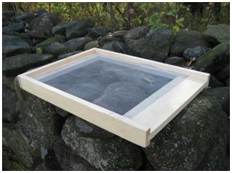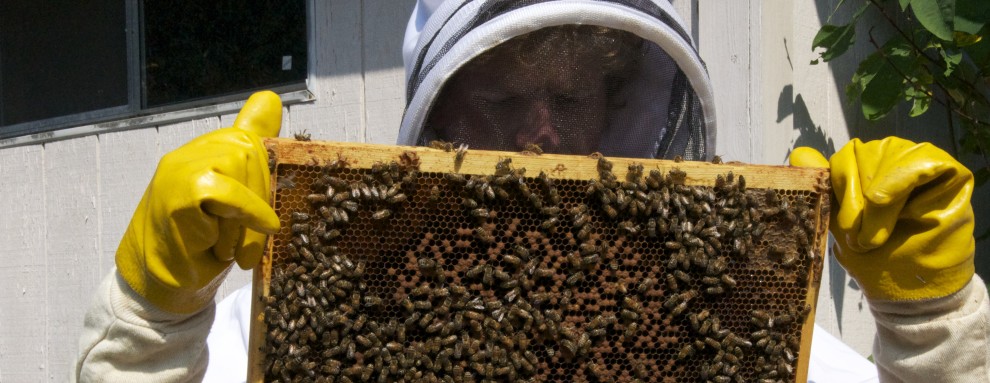Screen Bottom Boards (SBB) have a number of uses in our bee stewardship. They are widely substituted for a solid bottom board. A 1939 Delaware beekeeper removed his solid bottom and left his colony open at the bottom, which he termed bottomless beekeeping. There truly is nothing “new” in our beekeeping practice of using a screened bottom on hives. Although many beekeepers use SBB to control varroa, BIP and PNW surveys clearly point out they are not a very effective varroa mite control tool.
In our national BIP surveys, fully 95% of respondents indicate they have modified the colony bottom board and now use a screen bottom board.  Our PNW Honey Bee Survey also asked respondents about screen bottom board use. Among Oregon and Washington hobbyist (backyarders or small-scale beekeepers), 79% of the 250 respondents said they used screened bottoms; 66% used them on all their hives with the remaining 13% using them on a percentage of their hives (See figure right).
Our PNW Honey Bee Survey also asked respondents about screen bottom board use. Among Oregon and Washington hobbyist (backyarders or small-scale beekeepers), 79% of the 250 respondents said they used screened bottoms; 66% used them on all their hives with the remaining 13% using them on a percentage of their hives (See figure right).
Comparing overwinter loss percentage, there was no difference for the 21% who did not use SBB (27% loss rate , same as t he overall 250 respondent base) compared to the79% who did (25% middle column in left graphic – column on right of graphic is overall loss rate for those beekeepers using either 8-frame or 10 frame Langstroth hives – when the data for individuals who used other hive types besides Langstroth is included, the overall overwinter loss rate for backyarders was 29%).
he overall 250 respondent base) compared to the79% who did (25% middle column in left graphic – column on right of graphic is overall loss rate for those beekeepers using either 8-frame or 10 frame Langstroth hives – when the data for individuals who used other hive types besides Langstroth is included, the overall overwinter loss rate for backyarders was 29%).
We also asked whether they blocked colony SBBs during the winter. The majority (51%) left them open over the winter period  (never response). 19% sometimes blocked them and 31% said they closed them (always response) during the winter (see graphic right). When we examined winter losses for this response, there was no statistical dfference in loss, although the trend was for lower losses when the SBB were closed (24% vs 31%).
(never response). 19% sometimes blocked them and 31% said they closed them (always response) during the winter (see graphic right). When we examined winter losses for this response, there was no statistical dfference in loss, although the trend was for lower losses when the SBB were closed (24% vs 31%).
As stated above, SBB are not an effective mite control tool, although most beekeepers state they are using them for that reason. In our PNW survey, respondent beekeepers who said they used bottom boards as a non-chemical treatment option for varroa mites, had no statistical improvement in survivability. Langstroth 8-frame beekeepers who listed SBB use, entered winter with 97 colonies losing 25 by the spring (=25% loss rate) and Langstroth 10-frame beekeepers entered winter with 596 colonies of which 440 survived ( =26% loss rate); other hive types included in the survey (5-frame nucs, top bar hives or Warre hives) do not easily lend themselves to bottom modification with screening, although some individuals with such hives may use a partial bottom screen in place of a solid bottom.
With our Bee Informed National survey (www.beeinformed.org), use of SBB did not improve winter survival rate in any of our survey years when we directly compared their use with loss rates. However in survey year 2013-2014, northern beekeepers did have about a 10% decrease in losses when SBB were used compared to southern beekeepers. Experimental studies on SBB and mite population levels show either no or this slight ~10% improvement in reducing mite population levels when SBB are used.
So what can SBB do to benefit our bees?
Using a screen bottom aids greatly in hive ventilation.  It can be used with upper entrances at the covers or with ventilation ports added to hive bodies. Air circulation for better ventilation can be further aided by pushing the outer frames inward a bit to allow air circulation upward between the outer frame and box wall. Heavy burr and brace combs, sometimes due to incorrect bee spacing between the hive boxes, when both the bottom bar and the dropping of the top bars below the rim creates a ½ inch of larger space, and heavy propolis use in the fall, may reduce good air circulation in the boxes.
It can be used with upper entrances at the covers or with ventilation ports added to hive bodies. Air circulation for better ventilation can be further aided by pushing the outer frames inward a bit to allow air circulation upward between the outer frame and box wall. Heavy burr and brace combs, sometimes due to incorrect bee spacing between the hive boxes, when both the bottom bar and the dropping of the top bars below the rim creates a ½ inch of larger space, and heavy propolis use in the fall, may reduce good air circulation in the boxes.
During winter, beekeepers at more northerly locations or higher elevations often close or reduce the screen opening beneath their colonies. It is not advisable to have wind blowing into the bottom of a winter colony but an air space beneath the colony, with screen bottom board left open, is not detrimental to colony wintering. The dead air space and moderating soil temperatures may be helpful. Often this dead space beneath a screened bottom can be created with hive stand configuration.
Another advantage of a screen bottom board is that it provides for a convenient garbage pit to remove debris and fallen mites from a colony. The original Langstroth hive had such a feature but it was discontinued when the hive construction was simplified. They were thought to promote wax moth with the design Langstroth used.
Screen Bottoms may offer some improvement for some beekeepers, particularly where winter confinement period is long and when mite populations are lower. In is not clear if this improvement is due to mites alone or to the other effects a screen vs closed bottom may have on colony survivability (see below). As regards varroa mites they should be considered a tool that may reduce winter losses when used in combination with other mite control treatments and tools.
August 2015 Dewey M. Caron
To download a copy of this report click here
